Introduction: In this article, with Halloween being today, Melissa Davenport Berry writes about a haunted lighthouse in Boston Harbor and a family tragedy that befell its first keeper. Melissa is a genealogist who has a website, americana-archives.com, and a Facebook group, New England Family Genealogy and History.
Today I continue with the story of Captain George Worthylake, the first lighthouse keeper of Boston, who is still making waves today – both in the antiquarian world and the paranormal.
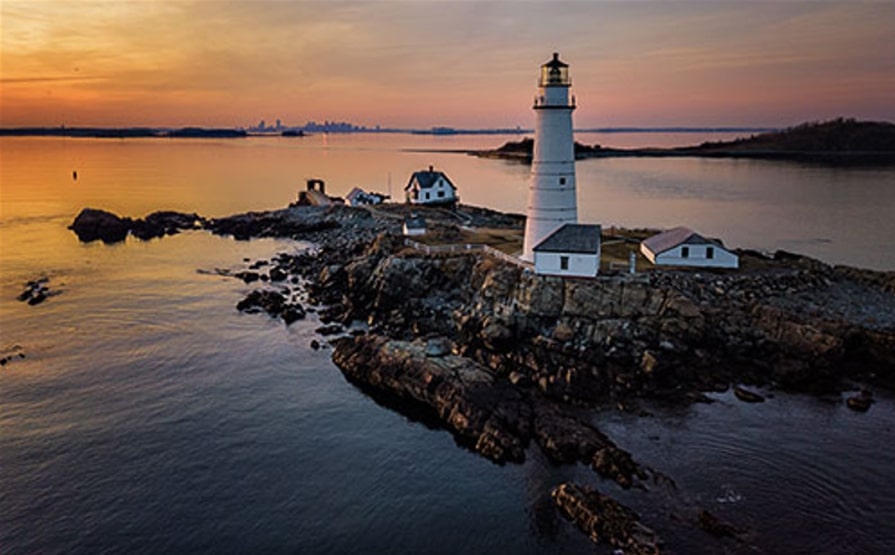
To recap: Part 1 covered how I found the story of Captain Worthylake when I assisted Elizabeth “Beth” Anne (Annis) Coughlin with proving her lineage for membership into the General Society of Mayflower Descendants. Elizabeth is a direct descendant of Mayflower passengers Elder William Brewster and John Billington through marriages into her Worthylake ancestors.
Two years after beginning his service in 1716 as keeper of Boston Light (the first lighthouse in what is now the U.S.), Captain Worthylake, along with his wife Ann, daughter Ruth, and two others drowned in Boston Harbor. Read more on this in Part 1.
Here is some additional history on the Worthylake family and lighthouse events before I get into the hauntings.
Cotton Mather Paid Emotional Homage to Worthylake Family
In the 1990s several rare Massachusetts documents surfaced, including two volumes of 300-year-old court documents from Massachusetts Bay Colony.
In Salem Richard Fyffe, the chief librarian of the Essex Institute (now PEM), identified a long text of a sermon delivered by Puritan leader Cotton Mather, predominantly known for his role in the 1692 Salem witchcraft trials. It was part of the sermon he read at the funeral of Worthylake on 9 November 1718. It was entitled “Providence Asserted and Adored.”
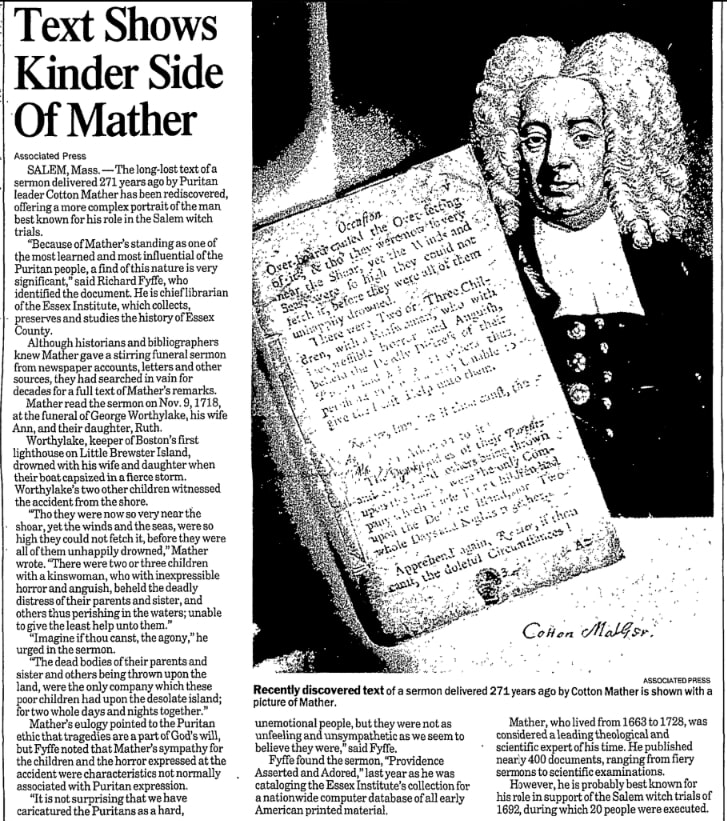
Part of Mather’s sermon:
“Tho[ugh] they were now so very near the shore, yet the winds and the seas were so high they could not fetch it, before they were all of them unhappily drowned. There were two or three children with a kinswoman, who with inexpressible horror and anguish beheld the deadly distress of their parents and sister and others thus perishing in the waters; unable to give the least help unto them. Imagine if thou canst, the agony. The dead bodies of their parents and sister and others being thrown upon the land, were the only company which these poor children had upon the desolate island for two whole days and nights together.”
What makes this find so unique? This article reports:
Mather’s eulogy pointed to the Puritan ethic that tragedies are a part of God’s will, but Fyffe noted that Mather’s sympathy for the children and the horror expressed at the accident were characteristics not normally associated with Puritan expression.
“It is not surprising that we have caricatured the Puritans as a hard, unemotional people, but they were not as unfeeling and unsympathetic as we seem to believe they were,” said Fyffe.
Ben Franklin Penned a Ballad on the Lighthouse Tragedy
Another famous historical figure, Benjamin Franklin, was rumored to have crafted a ballad about the Boston Light tragedy when he was just 14.
It was entitled “The Lighthouse Tragedy,” and reportedly reappeared in 1940 (after being lost for more than 175 years) when a lighthouse keeper’s son named Maurice Babcock Jr. came across a copy of it in an old attic on Brewster Island.
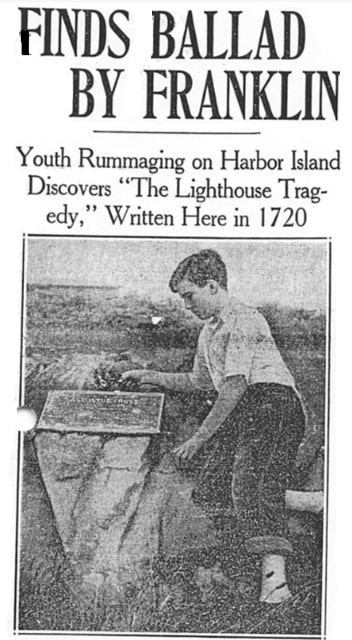
The photo caption reads:
Found Old Ballad. Maurice Babcock Jr., son of the keeper of Boston Light, who found a copy of what is believed to be the famous lost ballad that Benjamin Franklin wrote at the age of 14.
This celebrated discovery made headlines, like this one from the Reading Eagle that reports Babcock Jr. “found the tattered, yellowed, single sheet – in old English characters – in the pocket of a rotting leather jacket.”
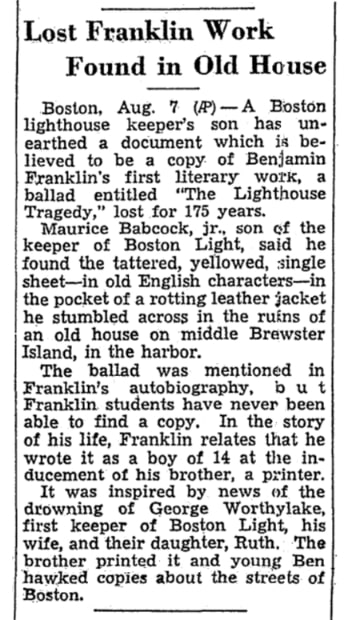
You can read the entire Franklin ballad found by Babcock Jr. and watch a video on the full skinny at New England Lighthouses.
Some experts, such as Zoltan Haraszti – former Keeper of Rare Books at the Boston Public Library – have claimed the manuscript proved on examination to be in a nineteenth-century hand, according to FoundersOnline.com, which cites an article Haraszti published that debunked the whole discovery of the ballad.
Second Lighthouse Tragedy Strikes Within Days of the First
This will send shivers up your spine! Less than two weeks after the Worthylake drowning, a second tragedy was reported at Boston Light: the death by drowning of two men hired to replace George Worthylake.
An article in the Boston News-Letter reminds readers of the “awful and Lamentable Providence” of the first incident, and reports the second.
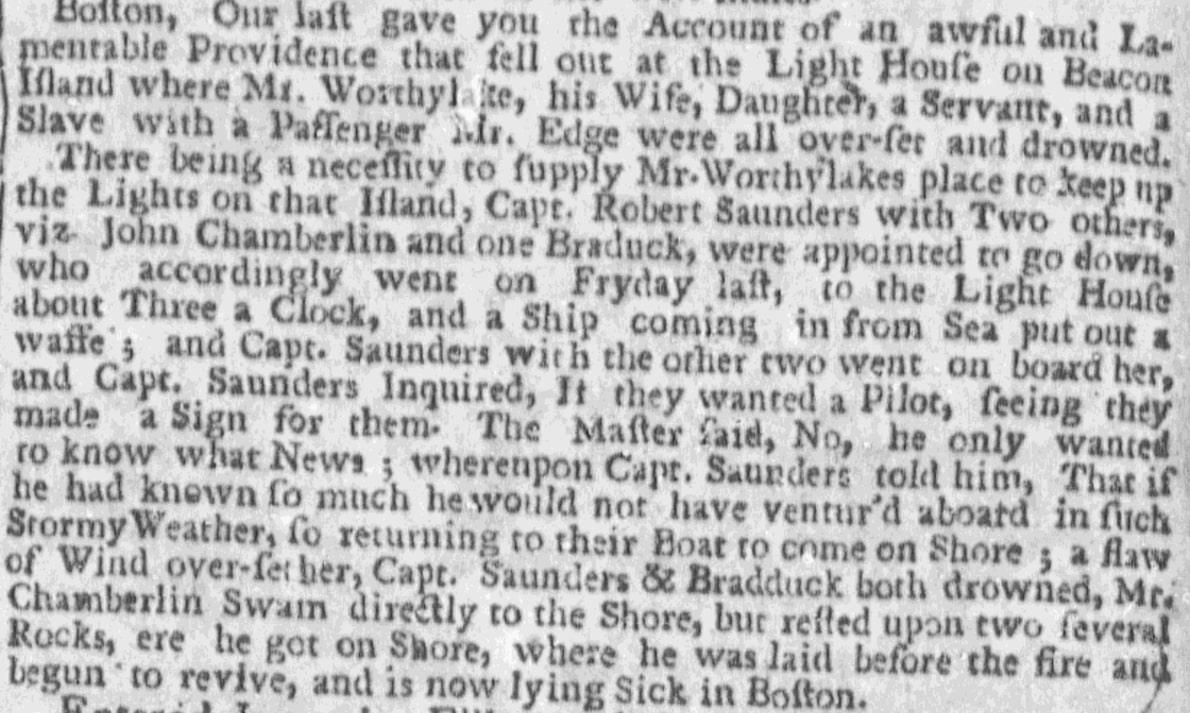
This article reports:
There being a necessity to supply Mr. Worthylake’s place to keep up the lights on that island, Capt. Robert Saunders with two others, viz John Chamberlin and one Brad[d]uck, were appointed to go down, who accordingly went on Friday last, to the light house about three a clock, and a ship coming in from sea put out a [flag]; and Capt. Saunders with the other two went on board her, and Capt. Saunders inquired if they wanted a pilot, seeing they made a sign for them. The master said, no, he only wanted to know what news; whereupon Capt. Saunders told him, that if he had known so much he would not have ventur’d aboard in such stormy weather, so returning to their boat to come on shore; a saw of wind overset her, Capt. Saunders & Bradduck both drowned, Mr. Chamberlin swam directly to the shore, but rested upon two several rocks, ere he got on shore, where he was laid before the fire and begun to revive, and is now lying sick in Boston.
A tablet listing all the Boston Light keepers, starting with George Worthylake, was unveiled by Fitz-Henry Smith, who authored a history of Boston Light. Historian and Flying Santa Edward Rowe Snow read a paper on the various keepers of the Light.
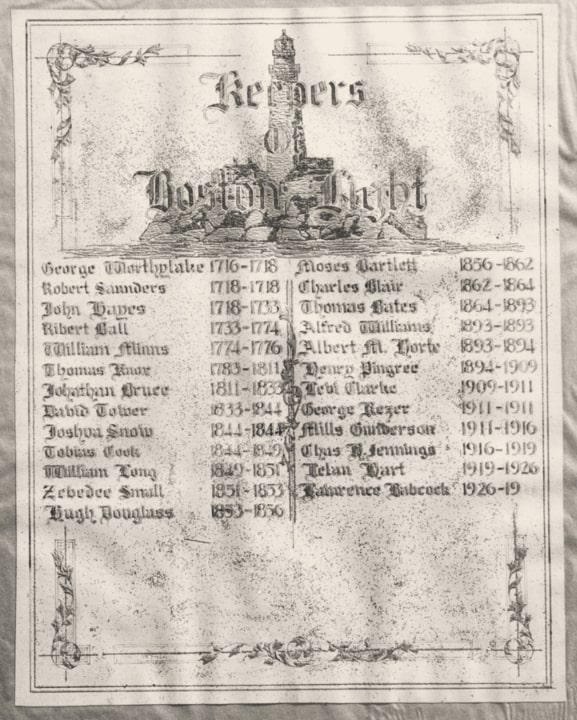
Here are two more photos taken the day of the unveiling of the Boston Light keepers’ tablet. This first photo shows the tablet being unveiled.
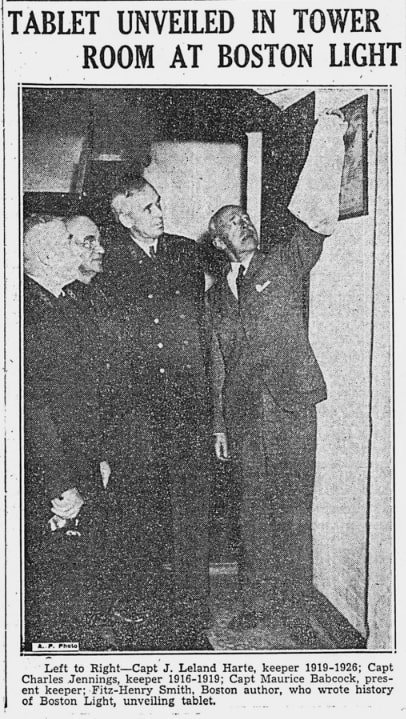
The photo caption reads:
Left to Right – Capt. J. Leland Harte, keeper 1919-1926; Capt. Charles Jennings, keeper 1916-1919; Capt. Maurice Babcock, present keeper; Fitz-Henry Smith, Boston author, who wrote history of Boston Light, unveiling tablet.
This next photo shows 10 of the 17 children who lived on Little Brewster Island while their daddies were keepers.
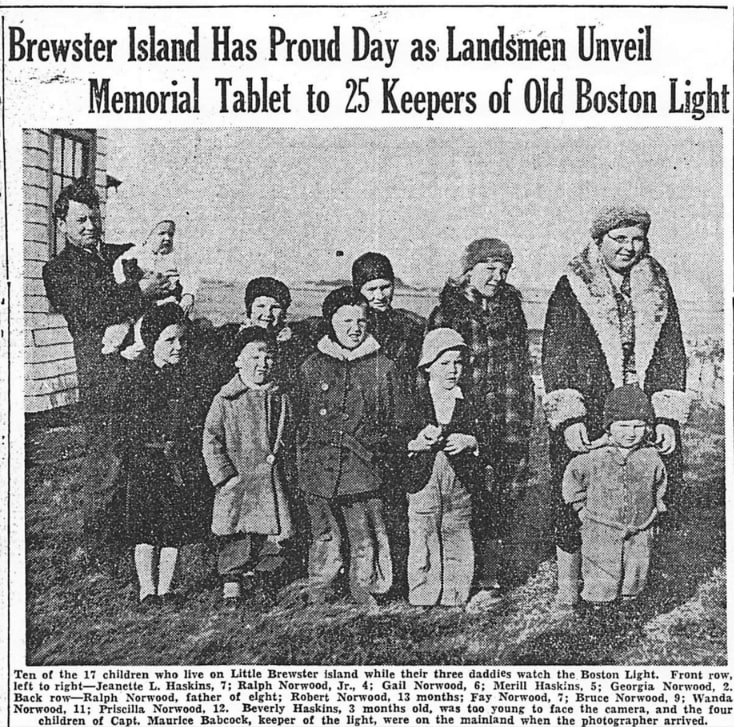
The photo caption reads:
Ten of the 17 children who live on Little Brewster Island while their three daddies watch the Boston Light. Front row, left to right – Jeanette L. Haskins, 7; Ralph Norwood Jr., 4; Gail Norwood, 6; Merill Haskins, 5; Georgia Norwood, 2. Back row – Ralph Norwood, father of eight; Robert Norwood, 13 months; Fay Norwood, 7; Bruce Norwood, 9; Wanda Norwood, 11; Priscilla Norwood, 12. Beverly Haskins, 3 months old, was too young to face the camera, and the four children of Capt. Maurice Babcock, keeper of the light, were on the mainland when the photographer arrived.
Stay tuned for reported hauntings!
Explore over 330 years of newspapers and historical records in GenealogyBank. Discover your family story! Start a 7-Day Free Trial
Note on the header image: Boston Light, Little Brewster Island, Boston Harbor, Massachusetts. Credit: Melissa Davenport Berry.
Related Articles:
- George Worthylake Still Making Waves with Boston Lighthouse (part 1)
- The Devil Went Down to Newbury (part 1)
- The Devil Went Down to Newbury (part 2)
- How the Accused Were Pinned for Witchcraft in Salem 1692
- Relics of the Salem Witch Trials Era (part 1)
- Relics of the Salem Witch Trials Era (part 2)
- Relics of the Salem Witch Trials Era (part 3)
- Relics of the Salem Witch Trials Era (part 4)
- Relics of the Salem Witch Trials Era (part 5)
